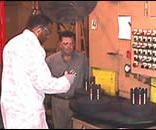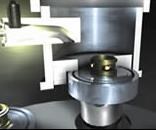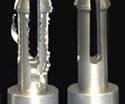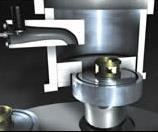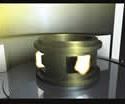Getting More Bang For Your Deburring Buck
Today, customers demand parts that are burr-free, which would suggest aggressive deburring. At the same time, they want parts that are free of scratches and dings, which calls for gentle processing. There is a non-conventional deburring process that not only completely removes burrs from even difficult-to-reach part areas, but also leaves machined features and surface finishes intact and parts free of nicks and scratches. The process is called thermal deburring.
Removing burrs from machined parts has always been a challenge, and never more so than it is today. Today’s screw machine parts typically require more machining operations, which leave more burrs—many of which are practically inaccessible yet must nevertheless be removed to preclude potential performance and/or reliability problems. Today, customers demand parts that are burr-free, which would suggest aggressive deburring. At the same time, they want parts that are free of scratches and dings, which calls for gentle processing.
Most shops find it difficult to satisfy those conflicting requirements with conventional bulk-type deburring methods. There is, however, a non-conventional deburring process that not only completely removes burrs from even difficult-to-reach part areas, but also leaves machined features and surface finishes intact and parts free of nicks and scratches. The process is called thermal deburring, and while it is not new—it has been available since the early 1970s—it is beginning to look like a process whose time has come.
Featured Content
As its name implies, thermal deburring employs heat to vaporize burrs and metal contaminants. Parts are loaded in a relatively small, thick-walled combustion chamber in a thermal deburring machine about the size of a small vertical machining center. The chamber is closed, mechanically sealed and then charged with a mixture of oxygen and combustible gas. The charge totally envelops each part in the combustion chamber, filling every opening and surrounding every burr. Finally, a spark ignites the charge, causing a detonation that creates a short burst of intense heat (up to 6,000°F) that oxidizes the burrs but leaves the rest of the parts metallurgically and dimensionally unaffected.
How Thermal Deburring Works
How can this process remove burrs without otherwise affecting the part? Machined burrs typically have a high surface area-to-mass ratio. Because they are very thin, these burrs oxidize very rapidly in the presence of oxygen at elevated temperatures. The oxidation occurs quickly and more or less uniformly along the entire burr, stopping where its base emerges from the relatively more massive body of the part, which acts as a heat sink to dissipate the heat. Although the detonation of the oxygen/gas charge generates enough heat to completely oxidize burrs (and similar unwanted production-process byproducts, such as flashing on a die casting), its duration is so brief that the temperature of the part itself becomes elevated only a few hundred degrees—not enough to affect it dimensionally or metallurgically—before it begins to cool.
The thermal deburring process was invented and patented as the Thermal Energy Method (TEM) by Surftran (now Extrude Hone Surftran), Madison Heights, Michigan, in the 1970s. The deburring takes place in a sealed combustion chamber, as described earlier. Parts are transported to the combustion chamber on a rotary indexing table containing as many as six (bottom) combustion-chamber halves. Parts to be deburred are (typically) manually loaded in a lower chamber half at the operator load/unload station (see photo below). The indexing table carries each lower chamber half loaded with parts into the machine, where it mates with the fixed upper chamber half to form the combustion chamber.
Setup for processing a particular part includes making the appropriate machine settings. The process is automatic and consistent from batch to batch, so the operator’s main responsibility consists of loading and unloading parts. A deburring cycle takes 30 to 35 seconds. Depending on the number of parts processed per cycle, a second operator may be assigned to the machine so that part loading and unloading matches the machine’s throughput rate.
Because the thermal deburring chamber is relatively small (standard sizes range from about 7 inches in diameter by 6 inches deep to 12 inches in diameter by 8 inches deep), the number of machined parts that can be deburred per cycle is limited and depends primarily on part size. Parts may be bulk loaded into basket-like containers that restrain the parts and keep them from bouncing around during the deburring process. (Along with the heat, the detonation creates a shock wave strong enough to move unrestrained parts against each other, possibly resulting in damage.)
Increasingly, thermally deburred parts are individually fixtured—plates with multiple cavities for holding parts, as shown at right, are a popular fixturing device—to hold the part in the most favorable position for the best deburring results and to prevent part-to-part contact. Appropriately designed fixtures can also be used to support small-diameter parts and serve as heat sinks for them to prevent distorting delicate areas.
Thermal Deburring Versus Other Processes
Thermal deburring requires a larger capital investment than conventional batch-type deburring processes. First, there’s the cost of the thermal deburring machines, which start at about $200,000. Secondly, fixtures must be designed, which usually necessitates a fixture designer, and produced to hold the parts for processing.
Before parts go through thermal deburring, they must be thoroughly cleaned to remove machining chips, coolants, oils and other contaminants that might interfere with the process. The parts must also be thoroughly cleaned after deburring. Although thermal deburring leaves no chips, deburring media, fines or particulates, the process converts burrs into an oxide of the parent metal that is uniformly deposited on the part. The oxide must be removed, usually with acid-based cleaners. More will be said about part-cleaning considerations a bit later.
Vibratory deburring of large quantities of parts at a time is probably the least expensive and most commonly used deburring method. It is widely used for removing external burrs on parts where minor surface flaws and slight rounding of corners are acceptable. However, vibratory deburring is less effective in removing internal burrs from recessed interrupted cuts, slots, intersecting holes and other internal features. Thermal deburring is more effective at removing internal burrs, even hard-to-reach burrs. In addition, where the vibratory deburring process can leave behind media, chips and other residues in difficult-to-clean areas of the part such as blind holes, tapped holes, intersecting bores and so forth, thermal deburring leaves nothing behind except a slight oxide coating that is easily removed in the post-cleaning process.
Another important advantage of thermal deburring is its consistency. The ability to reliably and consistently remove burrs from part to part and batch to batch makes thermal deburring the process of choice for air bag parts, fuel injection parts, valve components and other critical parts where burrs that become detached can not only adversely affect the performance of the end product but also possibly result in catastrophic failure.
In many cases the choice comes down to thermal deburring or hand deburring. Hand deburring is initially attractive because it’s familiar, it doesn’t require a substantial outlay for equipment and cost per part may appear to be low. However, the process is slow, particularly for parts that require the removal of multiple burrs. Equally important, results are inconsistent because of the many opportunities for human error: One or more burrs on a part may be missed by the person doing the deburring; whole parts may be missed; a burr may not have been completely removed; parts may have been damaged in handling; parts may have been damaged in the process of removing the burrs . . . there is no limit to the opportunities for error when work is done by hand.
By contrast, except for part loading and unloading, thermal deburring is a completely automatic process. The opportunity for human error is minimized, and results are consistent. The process is also considerably faster. A batch of parts, ranging from dozens to hundreds of parts depending on their size, can be thermally deburred in 30 to 35 seconds. It can take that long to hand deburr a single part. Increasingly, shops faced with the choice between hand deburring, and the opportunities it provides for defective parts to slip through, and thermal deburring, with the reliable, consistent results it provides, decide that there really is no choice.
Because the thermal deburring process is consistent, total processing times for a job can be calculated with a high degree of accuracy. That makes for more reliable scheduling. Costs are consistent from batch to batch as well, making for more reliable cost estimating.
Thermal deburring can be used on many ferrous and non-ferrous metals and thermosets and on thermoplastics without filler. The overriding consideration is the thermal conductivity of the material being processed. Commonly used steels are readily processed, but even highly conductive metals such as aluminum and brass can be accommodated by adjusting the processing parameters.
The Make Or Buy Decision
Some screw machine shops and manufacturing firms opt for in-house thermal deburring capability. One reason is that they are machining more complex parts that pose greater deburring challenges. Another reason is that part quality requirements are becoming more stringent, and more traditional deburring processes are failing to satisfy those requirements. Firms are recognizing that thermal deburring answers both needs, so they are installing in-house capability.
Also, as more and more conventional work is lost to overseas vendors, many U.S. shops are basing their growth strategies on specializing in more challenging jobs. As a result, they are investing in more sophisticated production equipment—and processes such as thermal deburring—to attract a more select class of customers and offer an array of state-of-the-art services that separates them from the competition.
Firms with in-house thermal deburring capability can fill idle time on the equipment by offering thermal deburring to other firms on a contract basis. The same reasons that make thermal deburring ideal for screw machine parts make it ideal for machined die castings, forgings, cold-headed parts, extrusions and so forth.
Companies that install in-house thermal deburring capability are generally product manufacturing firms and/or firms that process families of parts in large quantities. But firms don’t have to be large to enjoy the benefits of thermal deburring. They can take advantage of a number of deburring job shops that perform thermal deburring on a contract basis.
For example, Extrude Hone Surftran manufactures thermal deburring machines in a range of sizes for industrial customers, but the company also operates a ThermoBurr subsidiary, which consists of several job shops located in key U.S. industrial areas that offer a range of deburring processes, including thermal deburring, on a contract basis. Dave Koster, vice president of ThermoBurr at its Shelby Township, Michigan facility, offers a number of reasons why outsourcing thermal deburring is a smart move for any screw machine shop.
“Screw machine shops and other job shops have a lot of money invested in their highly efficient parts-manufacturing operations,” Mr. Koster begins. “These shops appreciate the advantages of having their parts thermally deburred, but rather than spend the money to install in-house thermal deburring capability, they’re more inclined to invest in equipment that improves their core business and outsource the thermal deburring work to shops that are as efficient at it as the shops are at their own specialties. Many firms believe that the key to success is to do only what you do best and rely on other suppliers of goods and services that are equally good at their specialties.
“Environmental factors must also be considered,” Mr. Koster continues. “Thermal deburring requires pre- and post-cleaning operations. Whenever you use water for industrial processing, you not only need a wastewater-discharge permit, but you’re limited to the amount of solids, phosphates and so forth that you can discharge. You must become knowledgeable about cleaning the various materials that you customers ask you to machine and be able to properly dispose of the byproducts of the cleaning process.
“Screw machine shops and other firms can avoid having to become waste-disposal experts by outsourcing the work to contract deburring shops that have already invested in the equipment and processes needed to comply with federal, state and local environmental regulations,” he continues. “By doing so, you also avoid the major investment in thermal deburring machines, cleaning equipment and wastewater processing. Also, if the jobs that you currently have that require thermal deburring come to an end, you are not saddled with expensive thermal deburring and part-cleaning equipment that you no longer need.”
One of the biggest advantages of dealing with a deburring job shop is being able to tap its expertise. The shop will usually have a range of deburring processes, including more modern processes such as electro-chemical deburring (ECD), high-energy finishing (HEF) and abrasive flow machining (AFM). Most deburring job shops will analyze your part and recommend the most appropriate method of deburring it. Sample parts are processed free of charge and generally returned in 72 hours or less.
Many screw machine shops have already made or are in the process of making the transition from older cam automatics to new CNC screw machines. With the new equipment, today’s shops are producing more sophisticated parts for more demanding customers. Sophisticated parts require equally sophisticated deburring processes. If you’re still trying to get by with hand deburring methods, you may be jeopardizing your relationships with companies with zero-defect programs that will no longer accept parts with burrs.



